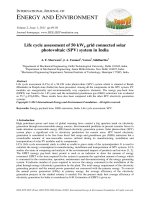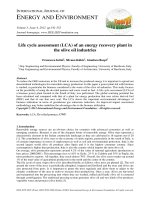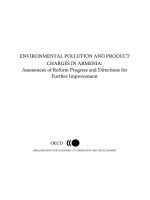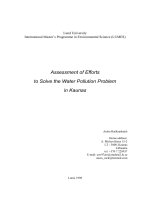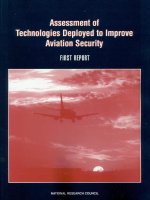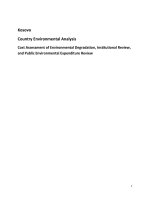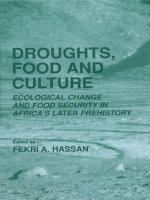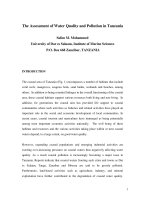Screening environmental life cycle assessment of printed,web based and tablet e-paper newspaper ppt
Bạn đang xem bản rút gọn của tài liệu. Xem và tải ngay bản đầy đủ của tài liệu tại đây (548.31 KB, 104 trang )
ISSN:1654-479X
TRITA-SUS Report 2007:1
KTH Centre for Sustainable
Communications
KTH 2007
Screening environmental life cycle assessment of printed, web based and tablet e-paper newspaper
ÅSA MOBERG, MARTIN JOHANSSON,
GÖRAN FINNVEDEN AND ALEX JONSSON
Centre for Sustainable Communications
Royal Institute of Technology, KTH
100 44 Stockholm
www.sus.kth.se
Screening environmental life cycle
assessment of printed, web based
and tablet e-paper newspaper
Reports from the KTH Centre for Sustainable Communications
Stockholm, Sweden 2007
1
Title:
Screening environmental life cycle assessment of printed, web based and tablet e-paper
newspaper
Authors:
Åsa Moberg, Martin Johansson, Göran Finnveden and Alex Jonsson
Reports from the KTH Centre for Sustainable Communications
ISSN:1654-479X
TRITA-SUS Report 2007:1
Stockholm, 2007
2
Acknowledgements
This work was performed as a co-operation between STFI-Packforsk and the Royal
Institute of Technology (KTH), division of Environmental Strategies Research and
department of Media Technology and Graphic Art. In addition, the study was a
forerunner in the recently established Centre for Sustainable Communications, a
Vinnova Centre of Excellence at KTH.
STFI-Packforsk and the Swedish Newspaper Publishers’ Association (TU) have
financed this study.
A reference group was very helpful and contributed in discussions and with some data
gathering, which the authors are thankful for. The reference group included Birgit
Backlund, STFI-Packforsk; Svenåke Boström, Sundsvalls Tidning; and Alex Jonsson
Media Technology and Graphic Arts at the Royal Institute of Technology. iRex
Technologies, through Philip Leurs, are acknowledged for helpfully providing
information about the Illiad e-paper device. Malin Picha and Stig Nordqvist at TU are
thanked for contributing with suggestions. Relevant comments from Carl Olsmats at
STFI-Packforsk are acknowledged.
Åsa Moberg was the project leader. Together with Martin Johansson she performed the
LCAs and wrote most of the report. Göran Finnveden and Alex Jonsson contributed
with their expertise and wrote minor parts of the report. Åsa is working at both STFI-
Packforsk, together with Martin, and at the division of Environmental Strategies
Research at KTH together with Göran. Alex is working at the department of Media
Technology and Graphic Art at KTH. In addition, Alex, Göran and Åsa are all heavily
involved in the Centre for Sustainable Communications at KTH.
3
Table of contents
Page
1 Introduction 10
1.1 Background 10
1.2 Life cycle assessment-general 12
1.3 Aim and scope 15
1.4 Guide to the reader 16
2 Scope and methodology of this study 17
2.1 Printed newspaper – European scenario 17
2.2 Web based newspaper – European scenario 22
2.3 Tablet e-paper newspaper – European scenario 27
2.4 Editorial work 33
2.5 Energy 34
2.6 Swedish scenario 38
2.7 Including internet infrastructure scenario 39
2.8 Web based newspaper with print-out scenario 40
2.9 Comparison between printed, web based newspaper and tablet e-paper
newspaper 43
2.10 Scope and methodology of the study 44
3 Results and discussion 48
3.1 Introduction 48
3.2 Printed newspaper 48
3.3 Web based newspaper 59
3.4 Tablet e-paper newspaper 73
3.5 Comparison 83
4 Discussion and overall conclusions 90
4.1 Printed newspaper 90
4.2 Web based newspaper 91
4.3 Tablet e-paper newspaper 91
4.4 Comparison 92
4.5 Future studies 95
4.6 Overall conclusions 96
5 References 98
5.1 Personal communication 100
5.2 Websites 101
5.3 Data sources 101
6 List of Appendices 102
4
Summary
Viable alternatives for regular newspaper have been available for roughly three years,
and often referred to as electronic paper, e-paper or e-readers. These products are meant
to carry many of the qualities of paper, such as reading using reflective light, high
resolution, 180° viewing angle, high contrast. These properties, along with its notably
low power consumption, distinguishes the e-paper displays from devices relying on
more traditional display technology, such as the LCD, CRT or plasma screen
components.
When an e-paper is used instead of a printed newspaper, the paper, the printing and the
physical distribution of the printed paper is avoided. The e-paper device has
substantially lower energy use during downloading and reading as compared to using a
computer for reading newspapers on the web. Thus, it has been suggested that the
environmental impact can be lower than for printed and web based newspapers.
However, a life cycle perspective covering raw material acquisition, production, use and
disposal, should preferably be used to study the environmental performance of the
products. In this way the shift of environmental impact from one part of the life cycle to
another can be avoided.
The aim of the present study was to describe the potential environmental impacts of
three studied product systems; printed newspaper, web based newspaper and tablet e-
paper newspaper. A screening lifecycle assessment (LCA) was performed, aiming to
draw conclusions on the potential environmental impacts of the three studied newspaper
systems. Another aim of the study was to identify data gaps and areas where more
information is needed. This is relevant in particular for the tablet e-paper, which is a
new product.
Sundsvalls Tidning (ST) was used as model newspaper, as this Swedish newspaper has
been produced and distributed as a printed newspaper, a web based newspaper and a
tablet e-paper newspaper. ST has performed a full scale test with an iRex Iliad e-paper
device, and thus could provide important input to this study. The scope of the study was
firstly to study a newspaper from a European perspective; with European electricity mix
and waste flows, etc. In addition, a Swedish scenario was tried.
The studied printed newspaper product system covered energy used for editorial work,
production of paper, transportation of paper, production of plates, ink etc for printing,
printing, distribution of newspapers and the waste management of disposed newspapers.
For the web based newspaper product system the energy used for editorial work,
formatting, down-loading and reading the information on a home computer was
included. Furthermore, the production and waste management of PC and screen was to
some extent covered.
In the product system tablet e-paper newspaper energy used for editorial work,
formatting, up-loading to a server, down-loading and reading the information on a tablet
e-paper was included. The production of the tablet e-paper was covered using screening
data where the component mix was taken from the electronic component configuration
5
of a personal computer motherboard and the e-ink screen was not included due to lack
of data. Waste management of the waste electronic device was to some extent included.
The LCA covered several different environmental impact categories; global warming,
acidification, eutrophication, ozone layer depletion, photooxidant formation and
resource use as well as toxicological impact categories. In addition the results were
weighted using two different weighting methods; Ecotax 02 and Eco-Indicator 99.
The results showed different patterns regarding where in the life cycle the main
potential environmental impact can be seen. For the printed newspaper the main activity
was the paper production, for the web based newspaper the energy for reading was
crucial and for the tablet e-paper newspaper the production of the electronic device
contributed the most to the potential environmental impact. Overall it can be noted that
the energy used for editorial work was an activity that also contributes to the total
impact. The figure used for energy used for editorial work did not include journalist
field work. Environmental impacts from the distribution of the printed newspaper were
significant, but not dominant for the results.
A comparison was made between the different product systems. The comparison was
made for a European and a Swedish scenario. In the comparison two versions were used
for the web based newspaper. Firstly, one where the web based newspaper was read for
10 minutes and 2.5 MB were downloaded and secondly, another where the reading time
was increased to 30 minutes (the same time as assumed for reading the printed and e-
paper newspapers) and 5.5 MB were down-loaded.
The comparison regarding the global warming impact category (Figure 1) indicated that
the web based newspaper (30 min) had the largest contribution in the European scenario
(35 kg CO
2
/year and unique reader) followed by the printed newspaper. The difference
between the web based (10 min) and the tablet e-paper newspapers was rather small.
In the Swedish scenario, the printed newspaper had the largest global warming
potential. The web-based newspaper had a lower global warming potential than the e-
paper newspaper when 10 minutes of reading was assumed.
The ranking from an environmental point of view was in general that tablet e-paper and
the web based newspaper with a shorter reading time (10 min), was giving rise to a
lower environmental impact than the printed version. With a reading time of 30
minutes/day the environmental impact of the web based newspaper was in general in the
same range as the printed newspaper environmental impact.
6
Global Warming Potential
0
5
10
15
20
25
30
35
40
Printed, Europé Web based 10
min, Europe
Web based 30
min, Europé
E-paper,
Europé
Printed, SE Web based 10
min, SE
Web based 30
min, SE
E-paper, SE
kg CO2-eqv./year and unique reader
Figure 1. Comparison between printed newspaper, web based newspaper (reading
time 10 and 30 minutes) and tablet e-paper newspaper. The comparison
regarded global warming potential, and the systems were compared within
the European and Swedish scenarios.
Some key aspects which may affect the resulting environmental performance of a
newspaper product system were identified:
• Number of readers per copy of printed and tablet e-paper newspapers
• Reading time for web based newspaper
• Lifetime of electronic devices
• Multi-use of electronic devices
In addition it was concluded that tablet e-paper has a potential for decreasing
environmental impact of newspaper consumption.
It should however be noted that this study was a screening LCA and conclusions drawn
from the study should reflect this. There were some missing data in this screening LCA
study. The major activities that were missing are the following:
• Journalist fieldwork (e.g. transportation)
• Production of tablet e-paper e-ink screen
• E-infrastructure
• Recycling of electronic waste
In addition, there are data missing for the use and emissions of hazardous chemicals.
7
Sammanfattning
Praktiska alternativ till den vanliga dagstidningen i pappersformat har funnits i ungefär
tre år, och bär handelsnamn som e-papperstidning, elektronisk dagstidning eller
läsplattor. E-pappersskärmar är utvecklade så att de ska innefatta många av papperets
kvaliteter, såsom att man läser med reflekterande ljus från omgivningen, hög
upplösning, 180-graders läsvinkel och hög kontrast. Dessa egenskaper tillsammans med
en låg energianvändning vid användandet utmärker e-pappersskärmar från elektroniska
produkter som baseras på traditionell bildskärmsteknik, t ex teknik för en LCD-; CRT-
eller plasmaskärm.
Om en dagstidning på läsplatta med e-pappersskärm ersätter en papperstidning kan man
undvika fleras teg i traditionell tidningsproduktion; pappersproduktion, tryckning
efterbehandling och fysisk distribution av tidningen. E-papper har påtagligt lägre
energianvändning vid nedladdning och läsning jämfört med användning av en dator för
att läsa tidningen på Internet. Tack vare detta har det antagits att miljöpåverkan kan
minskas genom att läsa en tidning på e-papper istället för på papper eller på webb. För
att bedöma miljöpåverkan av en produkt eller tjänst bör man dock anta ett
livscykelperspektiv, det vill säga ta hänsyn till hela livscykeln från råvaruutvinning,
produktion och användning till avfallshantering. I och med detta kan man undvika att
miljöpåverkan som sker i en del av livscykeln överförs till en annan.
Syftet med denna studie har varit att beskriva den potentiella miljöpåverkan från tre
produktsystem; papperstidning, webb-baserad tidning och en tidningsupplaga med e-
papper som informationsbärare. Förenklad livscykelanalys (LCA) utfördes för att kunna
beskriva dessa systems totala miljöpåverkan och var i respektive livscykel betydande
miljöpåverkan sker. Ett andra syfte med studien var att identifiera var det finns
dataluckor och områden där det behövs mer information. Detta är särskilt relevant för e-
pappersläsplattan som är en ny produkt.
Sundsvalls Tidning (ST) redaktionella produkter användes som utgångspunkt för delar
av studien, eftersom ST har producerats och distribuerats som papperstidning, som
Internetbaserad tidning och även som tidning för e-pappersläsplatta. ST har utfört ett
fullskaletest där en e-pappersläsplatta, en iRex Illiad, använts och därigenom kunde vi
få värdefull information från ST även i denna distributionskanal.
Studien har först och främst utförts med ett europeiskt perspektiv, med europeisk el-
mix, europeiska avfallshanteringsströmmar, etc. Dessutom har ett svenskt scenario
studerats.
Produktsystemet för papperstidning har inkluderat energianvändning för redaktionellt
arbete, pappersproduktion, transport av papper, produktion av tryckplåtar, färg och
annat som behövs för tryckning, tryckning, distribution av tidning samt avfallshantering
av tidning.
Produktsystemet för den webbaserade upplagan har inkluderat energianvändning för
redaktionellt arbete, formatering, nedladdning och läsning av tidningen på en
hemmadator. Dessutom har produktion och avfallshantering av hemmadator och skärm
inkluderats till viss del.
8
Produktsystemet för tidning på läsplatta med e-pappersskärm har inkluderat
energianvändning för redaktionellt arbete, formatering, nedladdning på server,
nedladdning till användarens läsplatta och läsning av tidningen på läsplattan. Dessutom
inkluderades produktion av läsplattan genom att ungefärliga data användes, bland annat
användes komponentsammansättningen hos en vanlig dators moderkort användes som
modell. Produktion av läsplattans skärmdel med inkapslade färgartiklar (från USA-
baserade E-ink) saknas på grund av databrist. Avfallshantering av läsplattan hanterades
till viss del inom studien.
Livscykelanalysen täckte in ett antal miljöpåverkanskategorier: växthuseffekt,
försurning, övergödning, ozonnedbrytning, bildning av fotokemiska oxidanter samt
påverkanskategorier för resursutnyttjande och toxikologisk påverkan. Dessutom
viktades resultaten samman på två olika sätt med hjälp av två olika viktningsmetoder;
Ecotax 02 and Eco-Indicator 99.
Resultaten visade på olika miljöbelastning från olika aktiviteter i de respektive
produktsystemens livscykler. För papperstidningen stod pappersproduktionen för den
mest betydande andelen av miljöpåverkan, för den Internetbaserade tidningen var
energianvändningen vid läsning avgörande och för tidningen på e-pappersläsplatta stod
produktionen av själva läsplattan för den största delen av miljöpåverkan. Generellt kan
det också noteras att energianvändningen för redaktionellt arbete märkbart bidrog till
den totala miljöpåverkan i flera fall. Denna energianvändning inkluderade inte
journalisternas fältarbete. Distribution av papperstidningen var av betydelse för
resultaten, men inte dominerande.
En jämförelse gjordes mellan de olika produktsystemen. Jämförelsen gjordes i ett
europeiskt scenario och i ett svenskt scenario. I jämförelsen användes två olika
versioner av Internetbaserad tidning. Dels en version där tidningen antogs läsas i 10
minuter och 2,5 MB laddades ner, dels en version där tidningen antogs läsas i 30
minuter (samma lästid som antagits för de två andra systemen) och där 5,5 MB laddades
ned.
För påverkanskategorin växthuseffekt (Figur 2) visade jämförelsen i det europeiska
scenariot att den Internetbaserade tidningen med 30 minuters lästid medförde den
största påverkan (35 kg CO
2
/år och unik läsare) åtföljd av papperstidningen. Skillnaden
mellan den Internetbaserade tidningen med 10 minuters lästid och tidningen på e-
pappersläsplatta var liten.
I det svenska scenariot hade papperstidningen den största påverkan i form av
växthuseffekt. Den Internetbaserade tidningen med 10 minuters lästid hade i detta fall
lägre påverkan än tidningen på e-pappersläsplatta.
9
Global Warming Potential
0
5
10
15
20
25
30
35
40
Printed, Europé Web based 10
min, Europe
Web based 30
min, Europé
E-paper,
Europé
Printed, SE Web based 10
min, SE
Web based 30
min, SE
E-paper, SE
kg CO2-eqv./year and unique reader
Figur 2. Jämförelse mellan papperstidning, webb-baserad tidning (lästid 10 och 30
min) och tidning på läsplatta med e-pappersskärm. Jämförelsen gällde
växthuseffekt i ett europeiskt och ett svenskt scenario.
Generellt rankades tidningen på läsplatta med e-pappersskärm och den webb-baserade
tidningen med en lästid på 10 minuter som mindre miljöbelastande än papperstidningen.
Med en längre lästid (här 30 minuter/dag) var miljöbelastningen från den
Internetbaserade tidningen generellt i samma spann som papperstidningen.
Några antaganden som kan vara avgörande för resultatet i en studie av miljöprestanda
för olika produktsystem för tidning identifierades:
• Antal läsare per papperstidningsexemplar och per e-pappersläsplatta
• Lästid för Internetbaserad tidning
• Livstid för elektroniska produkter
• Användning av elektroniska produkter för flera olika syften
Dessutom drogs slutsatsen att e-pappersläsplattan har potential för att minska
miljöbelastningen för en dagstidning.
Denna studie var en förenklad LCA och det bör reflektera de slutsatser man drar från
studien. Ett flertal dataluckor identifierades också, däribland:
• Journalistiskt fältarbete (t.ex. transporter)
• Produktion av läsplattans skärm
• Infrastruktur för elektronisk distribution
• Återvinning av elektroniskt avfall
Vidare så finns det dataluckor för användning och emissioner av farliga ämnen.
10
1 Introduction
1.1 Background
Viable alternatives for regular newspaper have been available for roughly three years
(Jan 2004), and often referred to as electronic paper, e-paper or e-readers. These
products are meant to carry many of the qualities of paper, such as reading using
reflective light, high resolution, 180° viewing angle, high contrast. These properties,
along with its notably low power consumption, distinguishes the e-paper displays from
devices relying on more traditional display technology, such as the LCD, CRT or
plasma screen components. Apart from the display itself, the e-readers consist mostly of
standard components, such as a plastic housing, a low-power one-chip microprocessor,
rechargeable battery, controller boards and implements for navigation, such as buttons,
jog wheels or stylus for browsing through your household electronic newspaper edition.
Some of the devices also carry an on-board wireless radio transceiver to automatically
download the latest edition on demand, which makes them similar in usage to a cellular
phone, only with about ten times bigger screen.
There are several patented methods on how to create and sustain an image on the e-
paper device, of which E-ink Technology (MIT start-up, founded in 1997) represents
the most widespread to date. Other companies with similar ideas, such as Epson and
Bridgestone, have yet to market their products in early 2007.
A crash course on the technology involves a 200 microns thin plastic laminate
sandwiching microcapsules containing both black (carbon) and white (titanium dioxide)
particles that are attracted to a negative or positive charge respectively (Figure 3). Once
an image is established, the static charge is held without consuming power for hours and
days until the image is updated again, when “flipping” to the next page.
Figure 3. Principle of electronic paper, courtesy of E-ink Technology.
11
Several device manufacturers, such as Sony, Motorola, Jhinke and iRex use the e-paper
substrate for their products, the Sony E-reader, the iRex Iliad, the Hanlin eBooks as well
as Motorola’s Motofone F3, which in fact is a cell phone targeting the Indian market
with a sales price of less than $100. The e-paper screen on-board contributes heavily to
the F3’s excellent performance with seven hours usage or near 17 days on standby on a
single battery charge.
Figure 4. The iRex Iliad, courtesy of iRex.
For the iRex Iliad (shown in Figure 4), the fact that the device only consumes power at
updates, and also that only parts of the page can be targeted, allows the device to carry
out over 7500 page flips before the Iliad needs to dock with its charging device. This
particular device is also subject to the full-scale test carried out at Swedish daily
newspaper Sundsvalls Tidning, as potentially viable alternative to reading the morning
newspaper either on paper or off a computer screen through the newspaper’s website.
When a tablet e-paper is used instead of a printed newspaper, the paper, the physical
distribution of the printed paper, etc are avoided. The e-paper device has substantially
lower energy use during downloading and reading as compared to using a computer for
reading newspapers on the web. Thus, it has been suggested that the environmental
impact can be lower than for printed and web based newspapers. However, a life cycle
perspective should preferably be used to study the environmental performance of the
products. In this way the shift of environmental impact from one part of the life cycle to
another can be avoided.
12
1.2 Life cycle assessment-general
1.2.1 Introduction
Life Cycle Assessment (LCA) is a method to assess the potential environmental impacts
and resources used throughout a product’s life from raw material acquisition through
production, use and disposal. The term ‘product’ can include also services. An ISO
standard has been developed for LCA providing a framework, terminology and some
methodological choices (ISO, 2006). An LCA is divided in four phases (Figure 5): Goal
and Scope Definition, Inventory Analysis (which is a compilation of the inputs and the
outputs of the system (Rebitzer et al, 2004), Life Cycle Impact Assessment (LCIA), and
Interpretation. The result from the Inventory analysis is a compilation of the inputs
(resources) and the outputs (emissions) from the product over its life-cycle in relation to
the functional unit. The latter is a description of the functions that the product (or
service) provides. All results in an LCA are related to this functional unit. In
comparative studies, the definition of the functional unit is essential so that the
alternatives are compared on a fair basis.
The LCIA phase is divided into several elements, some of which are regarded as
optional (ISO, 2006). The first elements of the LCIA (Classification and
Characterisation) are based on more or less traditional natural science and aim at
describing the contribution from the studied system to a number of environmental
impact categories such as resource depletion, human health impacts and ecological
consequences. One of the optional elements of LCIA is called weighting and includes a
valuation of different impact categories against each other. This may include different
types of monetisation methods or multi-criteria decision analysis techniques
(Pennington et al, 2004). In this step different types of values are required and natural
science alone is thus not enough.
There are two different types of LCA, accounting or attributional LCA and
consequential or effect-oriented LCA (see e.g. Baumann and Tillman, 2004). In
attributional LCA a system is described as it is. In consequential LCAs, the
consequences of a choice are modelled. These two types of LCA use different types of
data. The accounting type of LCA uses data for the processes which are used. This
means that different types of average data should be used, for example for the energy
system. In consequential LCAs, which reflect the changes, data reflecting processes
affected by these changes should be used. This normally means some sort of marginal
data.
13
Figure 5. A Life Cycle Assessment consists of four phases.
1.2.2 Allocation and system expansion
Life Cycle Assessment is one example of an environmental systems analysis tools
(Finnveden and Moberg, 2005). As in all types of systems analysis, the question of
system boundaries is essential. There are three major types of system boundaries that
are essential (Guinée, 2002):
1) between the technical system and the environment
2) between significant and insignificant processes
3) between the technical system under study and other technical systems.
In relation to the first system boundary, it can be noted that an LCA should cover the
entire life-cycle. Thus the inputs should ideally be traced back to raw materials as found
in nature. For example, crude oil can be an input, but not diesel oil since the latter is not
found in nature, instead it is produced within the technical system. In parallel, the
outputs should ideally be emissions to nature.
The second system boundary is further discussed in section 1.2.3.
The third system boundary results in so called allocation problems. They occur when a
process is shared between several product systems and it is not clear to which product
the environmental impacts should be allocated.
One example of an allocation problem is related to waste treatment and recycling.
Consider a printed newspaper. In the waste management phase it can for example be
incinerated with energy recovery. In this case, the waste treatment serves two purposes:
taking care of a waste problem and producing a new product: heat and/or electricity. If
Interpretation
Goal and scope
definition
Inventory
analysis
Impact
assessment
14
we are doing an LCA on newspapers, one may thus consider if the incineration plant
should be considered a part of the newspaper lifecycle or a part of the lifecycle of heat
and electricity or both.
There are two principally different ways of handling this type of allocation problems.
One is to allocate (partition) the environmental impacts between the two products
(newspaper and energy). This can be done on the basis of several principles e.g.
physical causation or economic value. The other principle to solve the allocation
problem is to avoid it by expanding the system boundaries and include both products in
the system model. In this approach the emissions from the incineration are included in
the product system, but an alternative competing source for energy is also included in
the system model. It is then assumed that the energy from the newspaper incineration
can replace energy from the competing source, which thus is avoided. The
environmental impacts from the competing energy source are then subtracted from the
environmental impacts from incineration of the waste paper. In this way the newspaper
system is credited for also producing heat and/or electricity. If the paper is recycled
instead of incinerated, the recycled material can replace paper from other sources. In the
same way as for incineration, the newspaper system can then be credited for avoiding
the production of paper from other sources.
The ISO-standard gives some guidance on how to handle allocation problems. It states
that whenever possible system expansion should be used to avoid allocation problems.
If that is not possible, an allocation reflecting the physical (or chemical or biological)
causations should be used, and finally if that is not feasible allocation based on other
measures, e.g. economic value, may be used.
Recycling of materials can occur in two different ways: closed-loop and open-loop. In
closed-loop recycling, the material is used to produce the same type of product again.
An example can be glass which is used to produce glass. In closed-loop recycling, the
modelling of the whole loop can be made within the studied product system and no
allocation problems will occur. In open-loop recycling, the material is used to produce
another type of product. One example is waste fine paper which is recycled into
newsprint.
1.2.3 Screening LCA – general
A full LCA can be time consuming and resource extensive. Instead of starting with a
full LCA, an alternative approach can be to perform a screening LCA with the aim of
identifying the most important aspects of the studied system. If wanted, more detailed
studies can then be directed to these important aspects (Lindfors et al, 1995).
A screening LCA is usually performed using easily accessible data. Since the aim is to
identify the most important processes, data quality is of less importance than in a full
LCA. It is important however to include all processes and materials that can be of major
importance. If however some processes or materials are known to be of minor
importance, they can be excluded.
A special type of easily accessible data comes from so called environmentally extended
input-output analysis (IOA). Input-output analysis is a well-established analytical tool
15
within economics and systems of national accounts (Miller and Blair, 1985). Input-
output matrixes describe trade between different sectors and industries in society. In this
way, it can for example be seen how much a specific industry (say food industry) is
buying from other industries (agriculture, machinery, transportation etc). These
industries are in their turn buying from other industries which in turn are buying from
other industries etc. Through mathematical manipulations, the whole picture can
however be described so that the total amount of products and services that are inputs
from all industries in order to produce an output from a specific industry can be
calculated.
Environmental information can be added to the IOAs by adding emission intensities for
the different sectors. The emission intensities are expressed as emissions per monetary
unit. Through the same type of mathematical manipulations, the upstream emissions to
produce a certain amount of products from a specific industry can be calculated. In this
way, environmental impacts from industries and broadly defined product groups can be
calculated.
1.2.4 Some earlier studies of relevance
Several studies of the environmental impact of printed media and paper have been made
(e.g. Larsen et al 2004; Johansson 2002; Axel Springer Verlag AG et al. 1998; Axelsson
and Dalhielm 1997). Web based newspaper reading has been compared to reading of
printed news in earlier studies (Yagita et al, 2003; Hischier and Reichart, 2001). Other
kind of information in printed or electronic for has also been compared from an
environmental perspective (Gard and Keoleian, 2002). E-paper newspaper has been
compared to printed an on-line newspaper in one earlier study found, and this study was
only published in German (Kamburow 2004). The study of Kamburow concerned
cumulative energy use (Kumulierten Primärenergieaufwandes, KEA).
The potential environmental impact of the production, use and waste management of
electronic equipment has been studied (e.g. Atlantic Consulting and IPU, 1998; Choi et
al., 2006; Lu et al., 2006). Andrae et al (2005) went through previous LCAs of
electronics and they state that there is a lack of representative component and material
data for LCA use. In some cases they find it hard to reveal whether intermediate
manufacturing processes are included in the case studies made. Andrae et al emphasise
that the intermediate upstream processes may in the adding up of impacts be significant.
1.3 Aim and scope
The aim of the project presented in this report was to describe the potential
environmental impacts of the three studied product systems; printed newspaper, web
based newspaper and tablet e-paper newspaper. A screening LCA was performed,
aiming to draw conclusions on the potential impacts. The results illuminate which
activities, i.e. parts of the respective product systems that are most important from an
environmental point of view. In addition, the results provide the opportunity to compare
the potential environmental impact of the three studied products systems, given the
assumptions made.
16
Another aim of the study was to identify data gaps and areas where more information is
needed. This is relevant in particular for the tablet e-paper, which is a new product.
Sundsvalls Tidning (ST) was used as model newspaper, as this Swedish newspaper has
been produced and distributed as a printed newspaper, a web based newspaper and a
tablet e-paper newspaper. ST has performed a full scale test with an iRex Iliad e-paper
device, and thus could provide important input to this study. A major part of the
newspaper data defining the three studied product systems are from ST, for example
edition, number of pages and number of readers. The scope of the study was firstly to
study a newspaper from a European perspective; with European electricity mix and
waste flows, etc. In addition, a Swedish scenario was tried.
1.4 Guide to the reader
In chapter 2 the scope and the methodology used in this study are described. The
systems studied are presented and major assumptions and missing data are noted. This
chapter lays the ground for the interpretation of the quantitative results. In chapter 3
characterised and weighted results are presented. In addition, all results of the impact
assessment can be found in Appendix 4. Chapter 3 may be heavy to read from A to Z. It
can be preferable to look for particular results or to jump back and forth between
chapter 3 and 4. Finally, in chapter 4 the results of the study are discussed, conclusions
drawn and some suggestions on interesting future research are made.
17
2 Scope and methodology of this study
Three different product systems were studied; printed newspaper; web based newspaper
and tablet e-paper newspaper. The product systems studied are described below as well
as major preconditions and assumptions made. Some specific processes are described,
since they were regarded as important (i.e. editorial work, electricity and heat). The
product systems were firstly studied with a European perspective (a European reader).
In this scenario a European electricity mix was used, as well as European waste flows.
Urban distribution was assumed, with lower fuel consumption per printed newspaper
than in the Swedish scenario. In the Swedish scenario a Nordic electricity mix and
Swedish waste flows were used. The main scenario was decided to be European to give
more general results than a Swedish scenario would. The Swedish scenario, as well as a
scenario where parts of the web based newspaper is printed, is described following the
European scenario. The scope and methodology of the study is further presented at the
end of this chapter.
2.1 Printed newspaper – European scenario
The printed newspaper that was studied here is described in Table 1. The data were
mainly based on information from Sundsvalls Tidning. The amount of copies and
readers have been estimated from the current edition (Boström, personal communication
2006) and the assumption that 2 000 readers will change to tablet e-paper. The
geographical boundary used was Europe and the paper used was assumed to be
European average 45 g/m
2
DIP (de-inked pulp) containing newsprint. The reading time,
30 minutes, was based on information from the Swedish Newspaper Publishers’
Association (TU, 2006). The reading time of the newspaper does not affect the
environmental assessment, but is an important aspect of the benefit of the printed
newspaper. The possible extra light needed for reading the printed newspaper was not
included in this study.
Table 1. Description of the studied printed newspaper
Parameter Printed newspaper
Edition 32 000 copies/day, 6 days/week
Size 40 pages
Format Tabloid (40x28cm
2
)
Number of readers 76 000 unique readers/day (2.4 readers per copy of newspaper)
Basic weight of paper 45g/m
2
Paper Newsprint DIP (de-inked pulp) containing
Reading time 30 minutes/day
Distribution Urban distribution
18
The functional unit of this product system was the yearly consumption of newspaper for
a unique reader (see 2.10.1) and it equals 131 newspapers/year (312 newspapers/year
and 2.4 unique readers/newspaper).
In the European scenario the assumption was that the content production, the production
of paper, the use phase and the waste management were taking place in Europe.
In Figure 6 the process plan for the printed paper, as illustrated in the Gabi software
used, is shown. The grey boxes represent underlying process plans with the same
principle structure of coupled processes.
Figure 6. Process plan for the printed newspaper product system.
The analysis has a full life cycle perspective. In the data one step back are presented, the
rest of the upstream and downstream processes are presented in Appendix 1. The
journalist fieldwork (e.g. transportation) was not included in the analysis.
19
Table 2 The life cycle of printed newspaper was modelled. This table only presents
data one step back. The rest of the upstream and downstream processes
are presented in Appendix 1.
Process Input Description Source of
data
Newsprint DIP
containing
Newsprint
DIP
Newsprint containing de-inked pulp (DIP) from post consumer
recycled paper. The dataset is based on several European LCA
studies made 2000-2002. The used electricity mix in the process
is Nordel 45%, UCTE 45% and GB 10% (for a description of
the mixes, see 2.5.1)
.
Raw material consumption for 1kg paper:
744 g wood (140% moisture)
302 g wood chips (70% moisture)
18 g sulphate pulp
757 g waste paper for DIP
Ecoinvent 1.2
Transportation
of paper
Train
Lorry
Transport, freight, rail, including the entire transport life cycle.
Data from 2000. Represents average transport conditions in
Europe (EU15).
Transport, lorry, 32 t., including the entire transport life cycle.
Data from 2000. Represents average transport conditions in
Europe (EU15).
Ecoinvent 1.2
Prepress Data from LCA studies by STFI-Packforsk (former
IMT/Framkom) on Swedish newspapers 1995-2002. The older
data sets have been adapted to current plate production
technology, computer to-plate (CTP).
STFI-
Packforsk
Electricity A mix of the three electricity systems UCTE, Nordel and GB. In
the European scenario 76:12:12 (for a description of the mixes,
see 2.5.1).
Electricity, medium voltage, production UCTE, at grid.
Electricity, medium voltage, production Nordel, at grid.
Electricity, medium voltage, production GB, at grid.
Ecoinvent 1.2
Gumming EU average 2000. Only data on energy use. STFI-
Packforsk
20
Process Input Description Source of
data
Offset plate Production of offset plate, EU average 2002.
Data on aluminium from Ecoinvent 1.2. Plate from 68% virgin
aluminium. The waste plates were assumed to be recycled into
new plates (closed-loop). The amount of recycled aluminium
which will not be part of the loop (approximately 68%) was
recycled (Aluminium, secondary, from new scrap, at plant) and
credited through avoided production of aluminium from virgin
resources (Aluminium primary at plant).
STFI-
Packforsk
Ecoinvent 1.2
Plate
developer
EU average 2000. Only data on energy use. STFI-
Packforsk
Editorial work
Electricity
Data from LCA studies by STFI-Packforsk (former
IMT/Framkom) on Swedish newspapers 1995-2002. Total
energy needed for the editorial office. Heat and electricity used
are not separately reported and the total energy use was
modelled as electricity.
See Prepress/Electricity.
STFI-
Packforsk
Printing Data from LCA studies by STFI-Packforsk (former
IMT/Framkom) on Swedish newspaper companies 1995-2002.
STFI-
Packforsk
Electricity See Prepress/Electricity.
Ink Data from earlier LCA performed by STFI-Packforsk (former
IMT/Framkom) on ink 1998-2002. Based on Swedish
production data with European electricity mix.
STFI-
Packforsk
Isopropanol
(IPA)
Data on Nafta production in Sweden, 1993. Allocation to the
part of the production that represents IPA and Cleaning agent
respectively.
STFI-
Packforsk
Cleaning
agent
See Printing/IPA.
Water EU average 2000, tap water at user. Ecoinvent 1.2
Distribution Average data from Swedish newspaper companies 2005 (Mint
project) divided into urban and rural distribution.
STFI-
Packforsk
Transport Small transporter/3.5t total cap./2t payload local, German data
from 1995. Only data on emissions of CO
2
, CO, dust, methane,
NO
x
, NMVOC and SO
2
from the use of the van.
Modified by STFI-Packforsk with data for urban distribution in
the European scenario, see above.
GaBi
Diesel Diesel free refinery. German data from 1997. GaBi
21
Process Input Description Source of
data
Reading No environmental impact from reading.
Incineration
with energy
recovery
Modified data from Ecoinvent 1.2; “Disposal, newspaper,
14.7% water, incineration CH”. Including avoided energy
production.
Net energy produced through incineration of waste paper:
• electric energy: 1.32 MJ/kg waste
• thermal energy: 2.77 MJ/kg waste
The avoided energy production (68% heat and 32% electricity)
was assumed to replace European mixes of electricity and heat
(see 2.5).
Data on avoided electric energy see Prepress/Electricity.
Data on avoided thermal energy from:
Hard coal, Germany 1996, GaBi data
Natural gas, Germany 1996, GaBi data
Light fuel oil, Germany 1996, GaBi data
Wood, EU 1996, BUWAL data in GaBi database
Ecoinvent 1.2
GaBi
GaBi
GaBi
BUWAL
Landfill Swiss data for landfilling, without energy recovery, “Disposal,
newspaper, 14.7% water, to sanitary landfill CH”.
The time perspective for emissions from the landfill was 100
years.
Ecoinvent 1.2
Recycling of
fibre
Closed-loop recycling (impacts of recycling included in the
process “Newsprint DIP containing”.
22
2.1.1 Major assumptions
The major assumptions made for modelling of the printed newspaper are summarised in
Table 3.
Table 3. Major assumptions made when modelling the printed newspaper product
system.
Field of assumption Assumption made
Transportation of paper Assumed distances: 400 km by truck and 1600 km by train,
European average. These assumptions were based on
Ecoinvent 1.2.
Distribution Assumed vehicle: van, 3.5 tonnes, payload 2 tonnes, local use.
Data from an internal STFI-Packforsk database (Mint) gave
estimations on fuel consumption for urban distribution: 0.0043
litre fuel/newspaper.
Recycled fibre and waste
management of post-consumer
waste paper
The paper waste streams, based on European statistics on
waste paper recovery for 2005 (CEPI, 2006):
• 60% recycling
• 30% landfill
• 10% incineration
Recycling of newspaper was modelled as closed-loop.
Landfill was modelled without energy recovery.
Incineration was modelled with energy recovery.
The offset plate used in the prepress was assumed to be made out of 68% virgin
aluminium. This was based on European average data from European Aluminium
Association (EAA) used in the Ecoinvent 1.2 database. The recycled aluminium was
treated as closed-loop. The amount of recycled aluminium which was not part of the
loop (approximately 68%) was modelled as recycled and credited through avoided
production of aluminium from virgin resources.
2.2 Web based newspaper – European scenario
The web based newspaper that was studied is described below. The figures on readers
per day and size of the electronic newspaper were from Sundsvalls Tidning (Boström,
personal communication, 2006). The reading time of 10 minutes per day was based on
Holsanova and Holmqvist (2004). Data on down-loading and power of electronic
equipment were assumptions made based on information on average equipment.
23
Table 4. Description of the studied web based newspaper
Parameter Web based newspaper
Edition 7 days/week
Size 2.5 MB/day
Number of readers 8 000 unique readers/day
Computer power 160 W
Screen power 120W
Down-loading speed 0.25 MB/s (2 Mbits/s)
Reading time 10 minutes/day
The functional unit of this product system, the yearly consumption of newspaper for a
unique reader (see 2.10.1), equals 913MB/unique reader and 61 hours of reading/unique
reader
In the European scenario the assumption was that the content production, the production
of paper and the use phase were in Europe, the production of the computer and screen in
China and the waste management in Europe. The process plan is shown in Figure 7.
Figure 7. Process plan for the web based newspaper product system.
24
The analysis has a full life cycle perspective. In Table 5 the data one step back are
presented, the rest of the upstream and downstream processes are presented in Appendix
1. Main processes not included in the study were the journalist fieldwork (e.g.
transportation), construction of infrastructure and use of infrastructure for electronic
distribution and material recycling of parts of the waste computer and screen.
Table 5. The life cycle of web based newspaper was modelled. This table only
presents data one step back. The rest of the upstream and downstream
processes are presented in Appendix 1.
Process Input Description Source of
data
Editorial office Electricity Total energy needed for the editorial office. Heat and electricity
used are not separately reported and the energy use was
modelled as electricity.
A mix of the three electricity systems UCTE, Nordel and GB. In
the European scenario with the ratio 76:12:12 (for a description
of the mixes, see 2.5.1).
Electricity, medium voltage, production UCTE, at grid.
Electricity, medium voltage, production Nordel, at grid.
Electricity, medium voltage, production GB, at grid.
Ecoinvent 1.2
Formatting web
based
newspaper
Electricity Energy needed for formatting.
See description of electricity above.
Ecoinvent 1.2
Downloading
web based
newspaper
Electricity Energy needed for down-loading the newspaper to the home
computer.
See description of electricity above.
Ecoinvent 1.2
Production PC The dataset contains screening life cycle inventories (LCIs) of
the devices:
• Housing
• Drives (Hard disc drive, Floppy, CD-Rom)
• PCI cards (Graphic card, Sound card, Network card)
• Power supply module and cables
• Populated Motherboard
The reference year is 2002.
No transportation or distribution included.
According to LBP, in the context of a screening LCA most
relevant flows are captured.
LBP,
University of
Stuttgart
